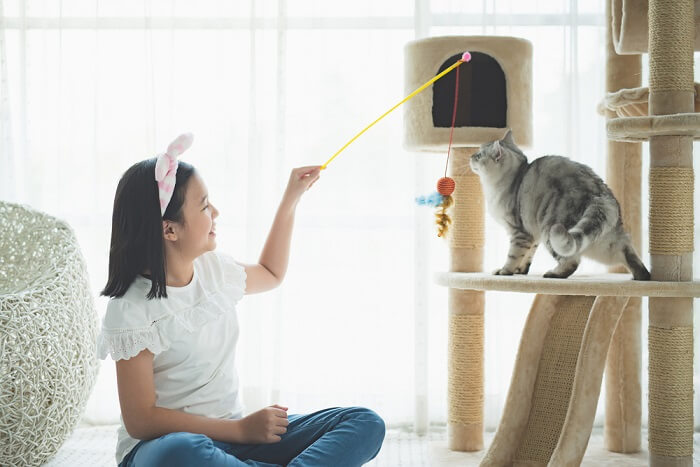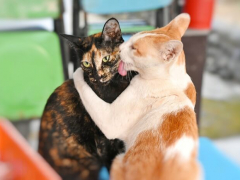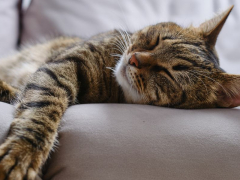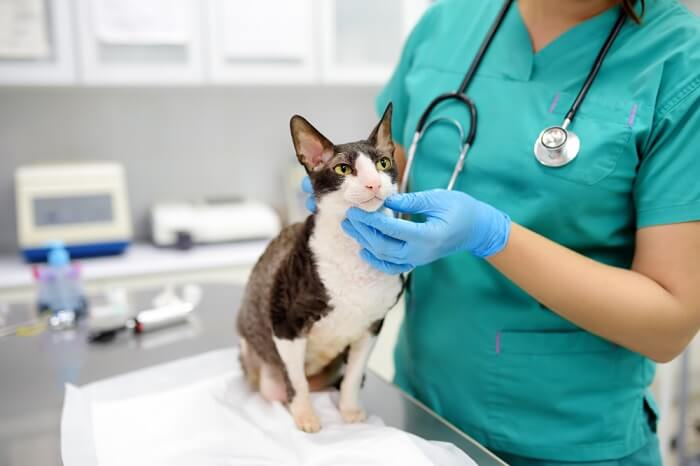
New Africa / Shutterstock.com
Cats are widely known for their autonomy and independence. Still, sometimes they crave attention from their human caregivers in very noticeable ways, which can be interpreted as disruptive or ‘naughty’ behaviors.
Cats seek attention for many reasons, including loneliness, boredom, or an unmet need. Attention-seeking behaviors may include excessive vocalization, destructive scratching, pawing or tapping, and deliberately knocking items off surfaces within your view. Learn how to respond to your cat’s attention-seeking behavior by offering structured routine play and engagement while avoiding reinforcing these undesired behaviors.Key Takeaways
Identifying and managing this attention-seeking behavior can help build a better relationship with your feline. In this article, we explore common signs of attention-seeking in cats, why they might rehearse these behaviors, and how you can address them in a healthy, effective manner.
Signs of Attention-Seeking Behavior in Cats

Destructive behaviors can be due to attention-seeking. Amanda Campion / Cats.com
Attention-seeking behavior can present in many forms, but understanding the cat’s primary motivation is often the same—your cat wants you to interact and be aware of them. Here are some of the most common indicators of this:
- Excessive Vocalization: Cats may use vocal cues to get your attention and eye contact. This might start as a meow but can become a persistent wail if they are not getting the desired attention and continue to be ignored.
- Pawing or Scratching You: If your cat gently taps you with their paw or claws on your face or limbs, they may be trying to signal that they want you to engage with them.
- Climbing on Your Lap or Keyboard: Cats may overtly place themselves on your lap while you are working at a computer or reading a book in an attempt to redirect your attention onto them.
- Knocking Things Over: Some cats will deliberately knock items off tables or counters to gain your attention. They may even make eye contact with you as they do this, as they have often learned from previous antics that this behavior gains them a quick response and interaction from their cat parent, thus rewarding their motivation.
- Shadowing You Around: Following you around the home, deliberately strolling in your path, especially when they know you’re busy, is another form of attention-seeking. This behavior can be beguiling but signals that your cat notably needs or wants your focus.
Why Do Cats Exhibit Attention-Seeking Behavior

A lack of mental stimulation or company can lead to attention-seeking behaviors. beka venezia / Shutterstock.com
Appreciating the motivation of attention-seeking behavior in your cat can assist in managing it effectively. Here are the most common reasons your cat might be rehearsing this behavior to gain attention:
Boredom or Lack of Stimulation
Cats are naturally inquisitive creatures that need both mental and physical stimulation to stay happy. They may resort to disruptive behaviors if caregivers do not meet their welfare needs with enough engagement and interaction. Indoor and solo cats, in particular, can feel bored and lonely without the stimulation of rotated, interactive toys, scratching posts for physical activity, and windows viewing the outdoors to look out of.
Loneliness
While cats can be happy as solitary pets, some can become lonely if they don’t get enough companionship. This is compounded further if you have only one pet, the cat is indoor only, or if you spend extended time away from home. Some cats can create strong bonds with their cat parents and may feel anxious or lonely when left alone for long periods.
Desire for A Predictable Routine
Cats thrive on a predictable routine in their environment and can quickly become distressed if their status quo is disrupted, such as a regular expected event is delayed or missed, like a meal or playtime. In that case, some cats will try to trigger you to react and prompt their expected activity by being extra attention-seeking.
Health Issues or Discomfort
Do be aware that what seems like attention-seeking could be a sign of underlying pain, discomfort, or health issues. Cats are wizards at masking and hiding any pain. This is an innate survival skill they have inherited from their ancestors. So, If your cat’s behavior changes suddenly or becomes more intense, it can be a red flag and a call to action to check in with your veterinarian to rule out any medical issues.
Positive Reinforcement from Caregivers
Attention-seeking behaviors can develop because we unintentionally reinforce them through our reactions. For example, suppose your cat learns that excessive meowing, frantic scratching of carpets or furniture, or knocking an item off a shelf gets a swift response from you. In that case, they’ll quickly learn that that particular activity paid dividends and had the desired outcome. So, even an adverse reaction by the caregiver to their antics is a positive result for the cat.
How to Address Attention-Seeking Behavior in Cats
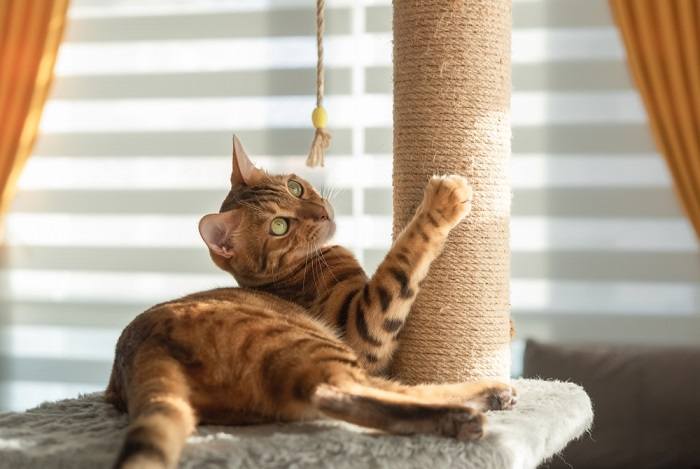
Provide plenty of opportunity for natural behaviors such as climbing, scratching and playing
Once you’ve identified your cat practices attention-seeking behavior, it’s essential to respond in ways that meet your cat’s needs without encouraging further rehearsal in these disruptive actions.
Create a Consistent Timetable for Play and Interaction
Cats thrive on routine. By setting aside predictable times each day for engagement, be it play, feeding, grooming, or affection, you can help reduce their urge to demand attention in the first instance. Try to use toys that mimic prey to stimulate their hunting instincts. For example, a wand toy can be used aerially to mimic insects or birds and low down on the ground to emulate ground prey.
Provide Enrichment Activities
Offer your cat various mental and physical enrichment activities to keep them entertained. Engage in interactive play sessions, provide foraging and puzzle feeders, and provide physical exertion, including climbing opportunities.
These are excellent ways to stimulate your cat’s mind and provide healthy outlets for their energy. Window perches can also be an excellent way for them to watch birds or squirrels outside, satisfying their predatory needs without being disruptive.
Redirect Attention-Seeking Behavior
If your cat scratches the carpet for attention, redirect them to a more appropriate activity. For example, gently move them to a designated ‘kitty-creche’ play area or give them a puzzle feeder. Reward your with treats or praise when it engages in these appropriate activities instead of disruptive ones.
Ignore Undesired Behavior
Ignoring your cat when they engage in disruptive attention-seeking rituals can be effective, though it requires consistency and patience. By not reacting to their display of negative behaviors (like knocking things over or excessive wailing), you reinforce to them that these antics won’t get them the desired outcome. However, ensure that you provide all their welfare needs and sufficient positive attention at other times so they don’t need to engage in negative attention-seeking behavior.
Reward Positive Behavior
When your cat engages in independent play, relaxes calmly near you, or displays the behavior you want to reinforce, give them a little extra attention or a small treat to encourage this positive behavior. This tactical approach encourages cats to seek attention in non-disruptive ways and ensures they get the positive attention they seek when not acting out to get it.
When to Seek Professional Help
If you have previously considered these strategies, your vet has ruled out any underlying health conditions, and your cat’s behavior has not improved, it is worth consulting with a certified cat behaviorist.
Sometimes, persistent attention-seeking can be linked to more embedded behavioral issues that need to be addressed by a professional. A feline behaviorist can help determine if there’s an underlying cause for the behavior and also assess your environment, and offer personalized strategies to manage your cat’s behavior effectively.
Attention-seeking behavior in cats can indicate that they crave more human interaction, engagement, or predictability in their lives. Addressing their welfare needs critically and creating a stimulating, engaging environment can help your cat feel satiated and secure without having to resort to rehearsing disruptive behaviors.
Patience and consistency are key to guiding your cat toward more positive interactions and engagement with you. With time and the right strategies, you can bolster your bond with your cat and enjoy a more peaceful, happy home environment. Happy Cat = Happy Human!
Frequently Asked Questions
Why does my cat meow at me constantly, even when I’ve fed and played with them?
Constant meowing can give your cat extra attention, but it may also indicate they want more stimulation or are feeling lonely. Ensure they have enriching activities, like interactive toys or scratching posts or a Pet Buddy smart speaker skill playing, especially if you’re away during the day. Sometimes, cats also meow excessively out of habit, especially if they’ve learned it reliably gets a response. Ignoring this meowing while reinforcing quiet, calm behavior can help retrain them over time.
My cat keeps knocking things off tables when I’m around. How do I stop this?
Cats may knock items off tables for fun, to explore, or to get your attention. If this becomes a habit, redirect them to other toys or activities when they seem to be getting into “knocking off” mode. You might also try offering them a few safe items they can bat around instead, such as toy mice or balls. Be sure to reward them when they play with these alternative objects. Avoid reacting too much when they knock things over—giving minimal response can discourage attention-seeking behavior.
Can attention-seeking behavior be a sign of health issues?
Yes, sometimes what appears to be attention-seeking behavior can indicate an underlying health concern, especially if it’s sudden or unusual. Excessive vocalization, clinginess, or behavior changes may signal pain, anxiety, or a medical condition like hyperthyroidism. If your cat suddenly becomes more vocal, clingy, or displays unusual behaviors, it’s important to consult a veterinarian to rule out any health concerns.



